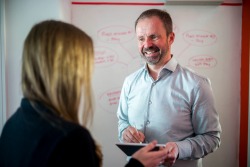To speak, or not to speak – that is the question facing business leaders and communications teams when it comes to sustainability. To speak risks being scrutinised and accused of greenwashing, to choose to stay quiet – commonly known as greenhushing – means intentional underreporting of green credentials and a lack of active participation in the global corporate drive for climate action.
choose to stay quiet – commonly known as greenhushing – means intentional underreporting of green credentials and a lack of active participation in the global corporate drive for climate action.
Businesses have a leadership role to play in climate action: our planet needs courageous enterprises to join the millions of voices worldwide who are fighting for change, serving as inspiration for others to do the same.
Demonstrating sustainability is also crucial for businesses in terms of customer retention, growth and trust. Research from Expleo as part of its Business Transformation Index shows that 54% of businesses have lost customers due to an unimpressive sustainability performance. Additionally, an increasing number of investors are taking sustainability into consideration for investment decisions.
When it comes to climate and environmental communications, the one thing to avoid is empty rhetoric; businesses must be able to back up opinions with evidence that they themselves are working towards real change. A fear of greenwashing must not become a crippling factor in doing this. Many are making genuine efforts to become more sustainable and these efforts are commendable, inspirational and worthy of praise.
What is greenwashing?

When considering how to avoid greenwashing, we must remind ourselves of what, exactly, it is. The United Nations states that ‘…by misleading the public to believe that a company or other entity is doing more to protect the environment than it is, greenwashing promotes false solutions to the climate crisis that distract from and delay concrete and credible action.’
Note that genuine efforts to become more sustainable are not identified as ‘greenwashing’ in this definition. So, while a company may still be on its journey to net zero, that does not prohibit it from speaking about its progress – just as long as that progress is truthful, transparent and authentic.
Why should we avoid greenwashing?
The negative consequences of greenwashing are aplenty – not least because businesses can risk regulatory repercussions. New EU legislation aims to hold companies to account to ensure their sustainability claims are accurate, with risks of significant fines and reputational damage if found to be in breach of the law. Businesses can also be held legally accountable for misleading advertising, as was the case with KLM when its reporting of sustainability efforts was found by a Dutch court to be illegal, as it gave passengers a ‘too-rosy picture’ of how sustainable it is to fly with the airline.
Incidents such as these are problematic. They not only harm the reputation of the company involved, but they also lead to public mistrust and greater hesitation among businesses to publicly celebrate their progress. So, it is important that companies understand how to avoid greenwashing, while also ensuring they don’t hide their environmental achievements – something that is referred to as ‘greenhushing’.
but they also lead to public mistrust and greater hesitation among businesses to publicly celebrate their progress. So, it is important that companies understand how to avoid greenwashing, while also ensuring they don’t hide their environmental achievements – something that is referred to as ‘greenhushing’.
How to avoid greenwashing
At Comit, we have spoken to climate change experts and academia on how to avoid greenwashing and their message is clear: just be honest. It seems simple, doesn’t it? And it is – kind of.
Some of this call for transparency speaks for itself. When reporting their sustainability achievements, businesses must be careful not to over-emphasise their impact. It’s no different to any other external communication: always stick to the facts. Seemingly innocuous yet aspirational statements like: “This is a significant step towards our goal of becoming carbon neutral by 2030” may have a nice ring to them, but unless there is very significant evidence to back this up, it should be left out. If the announcement truly is significant, journalists will very quickly see this and report on it.
 As a PR agency, we know that one way to grab journalists’ attention is by including impressive figures in headlines and press releases. It makes sense: figures can convey the magnitude of any given announcement and they back up the story. But these figures can be scrutinised and arguably, the most scrutinised figures right now are those which relate to environmental achievements. This doesn’t mean that figures such as emission savings should not be reported, but they, and the wording around them, must be fact-checked with the relevant company expert or external consultant.
As a PR agency, we know that one way to grab journalists’ attention is by including impressive figures in headlines and press releases. It makes sense: figures can convey the magnitude of any given announcement and they back up the story. But these figures can be scrutinised and arguably, the most scrutinised figures right now are those which relate to environmental achievements. This doesn’t mean that figures such as emission savings should not be reported, but they, and the wording around them, must be fact-checked with the relevant company expert or external consultant.
Sustainability communications require self-awareness
Once the facts, and the presentation of the facts, have been carefully examined, it is important to also look at the business as a whole when considering how to avoid greenwashing. Is the rest of the business highly pollutant and engaging in unethical labour practices, aside from one arm that has just planted 50 trees? Along with their communications team or PR agency, businesses must assess their sustainability achievements relative to their overall business operations and decide if this announcement is enough, or is it just masking a much larger issue?
Avoiding greenwashing means sustainability communications and claims must never be used to hide real, concerning environmental issues. But it is OK to have more work to do. All of us have more work to do. Being honest about this will build trust with consumers and partners, while also demonstrating that climate action is a journey – a hard one – but the sum of small, continuous actions can be mighty.
A careful approach to this is key. As communicators, it is our job to share good news. But as we have seen, sustainability leadership requires honesty and openness. It requires sharing the news, but also highlighting the areas that will be addressed next, or what is already being worked on. It’s saying: we’re not perfect, but we are trying and we are getting there. This message should be adopted not just for media announcements, but for public commentary and media interviews, too.
seen, sustainability leadership requires honesty and openness. It requires sharing the news, but also highlighting the areas that will be addressed next, or what is already being worked on. It’s saying: we’re not perfect, but we are trying and we are getting there. This message should be adopted not just for media announcements, but for public commentary and media interviews, too.
A great example of this is Lego, a multinational trading on small pieces of plastic. The company is trebling its spend on sustainability initiatives and is phasing out single-use plastic packaging, with the aim of using entirely sustainable packaging by 2025. Its bricks remain plastic, but Lego has been open an honest about what it is doing to address this. It is committed to developing a sustainable brick; it has been hard, there has been no Eureka! moment yet, but Lego has been transparent about its efforts throughout.
This is where we can see true sustainability leadership being communicated. It is not a one-way train to net zero; there are ups and downs along the way, along with great successes. The more we share stories like these, the more informed and united we will become in this vital movement for our planet.
Tell us about you
 We would love to hear about your company’s sustainability journey and the challenges and successes that you have had in communicating that. By sharing your experiences, you can learn valuable strategies on how to avoid greenwashing and greenhushing. We can help you to craft genuine sustainability messaging and elevate the stories that will make a difference to your company, and to the environment.
We would love to hear about your company’s sustainability journey and the challenges and successes that you have had in communicating that. By sharing your experiences, you can learn valuable strategies on how to avoid greenwashing and greenhushing. We can help you to craft genuine sustainability messaging and elevate the stories that will make a difference to your company, and to the environment.
Contact us today to embark on a journey towards genuine environmental stewardship. Let's navigate the complexities of greenwashing and greenhushing together.
